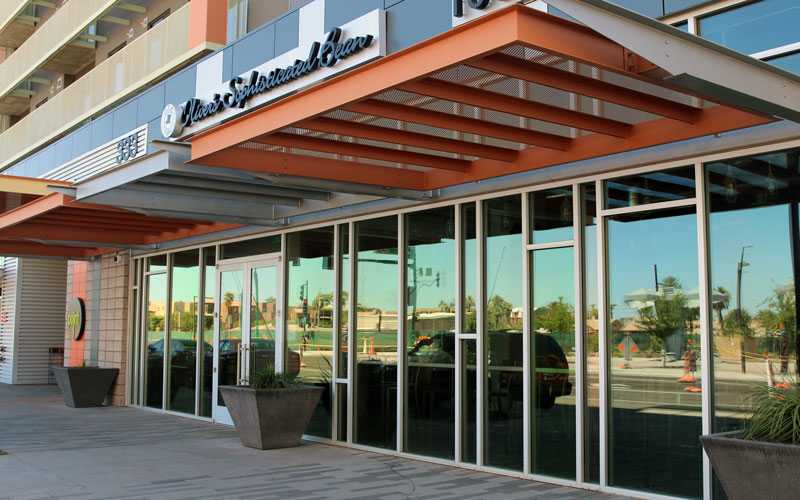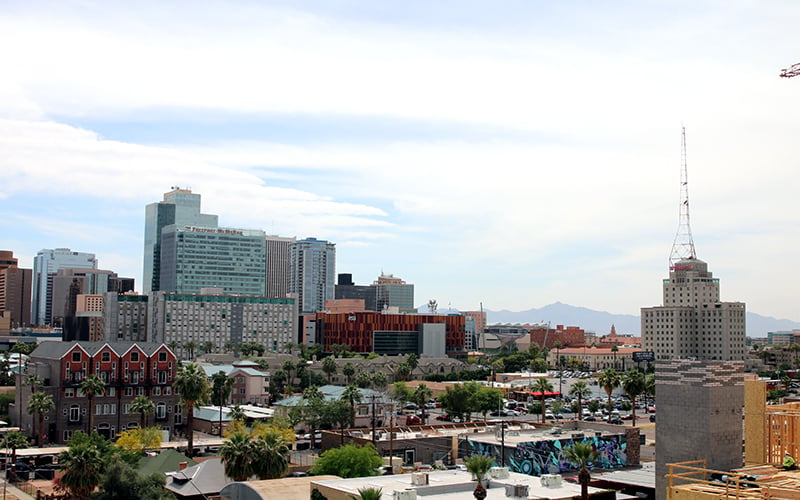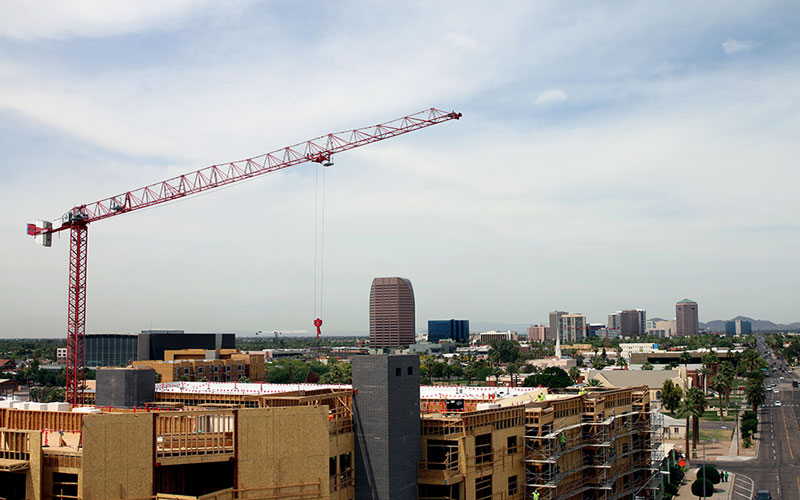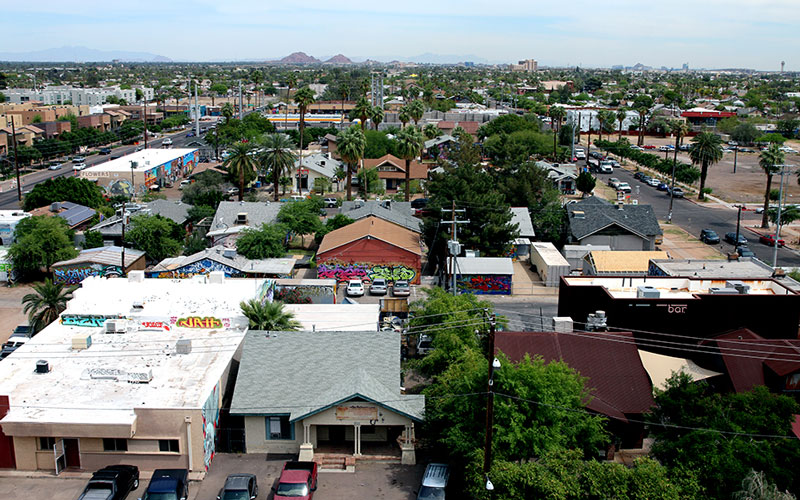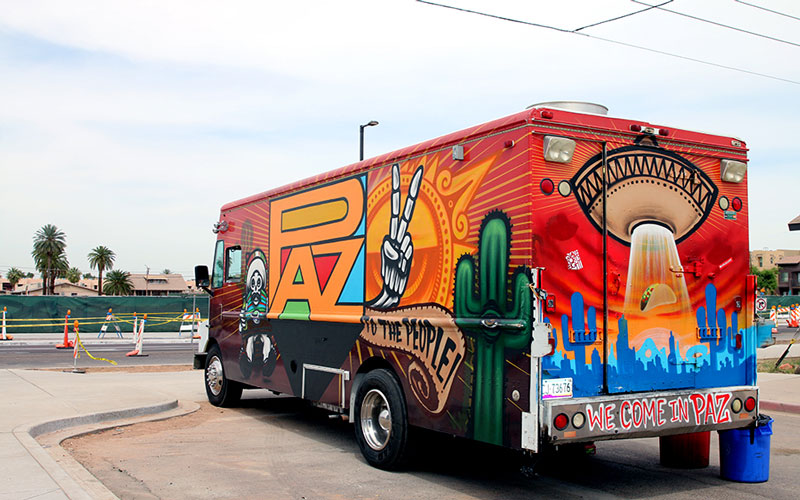PHOENIX – Downtown Phoenix streets, once scattered with vacant lots and modest housing, are now abuzz with the ceaseless sounds of cranes, backhoes and tractors.
More than 20 apartment and condo buildings are rising, a boom that will add more than 2,000 living spaces by 2017.
Expectations also are rising. City officials and residents say walkable, lively streets and ground-floor storefronts are priorities in the evolving downtown landscape. Planners, community members and developers are tackling plans to take the downtown of the nation’s sixth largest city from good to great.
But some plans are not living up to the priorities, some advocates say, for a host of complicated reasons. City officials encourage development, often providing tax incentives, but do not hold developers accountable for preserving existing communities. Housing developers are focused on a business model where housing is more lucrative than retail and sometimes have trouble filling spaces for shops and restaurants. The momentum for housing is building faster than the businesses to serve people who live, work and visit downtown.
Innovations are on their way, according to developers, community activists and downtown advocates, but it will take time, determination and policy changes.
Vacant façades become vibrant streets
Some housing complexes in the city’s core have struggled to fill ground-level retail space, leaving stretches of vacant storefronts along blocks that could otherwise be a vibrant downtown environment.
Phoenix enacted its Walkable Urban Code last year in an effort to encourage more lively downtown streets. The code requires designs to include features that make sidewalks and streets more attractive and accommodating to pedestrians, like trees, shade structures and interesting façades. It also allows spaces to be mixed-use, so a restaurant or office can be located right next to an apartment or condo.
Downtown Building Boom by the Numbers:
(Source – ABI Multifamily)
Phoenix planner Vania Fletcher, who helped write the code, said by blending residential, commercial and office spaces, planners and developers can build more diverse and flexible neighborhoods — dense areas with interesting and lively ground floors that lead to a great downtown.
A similar code was enacted in 2008 to guide development downtown in an area bounded by 7th Avenue and 7th Street, McDowell Road to the north and Buckeye Road to the south. The Downtown Code outlines shade, pedestrian-friendly faćades and commercial space on ground floors as critical components for future development.
“Downtowns are great not because of all of the buildings, but because of all of the people that are populating the sidewalks, that are interacting, that are producing great stuff,” said Dan Klocke, vice president of development at Downtown Phoenix Inc., a community development group that supports the revitalization of downtown.
Roosevelt Point apartments, on the corner of Roosevelt and 3rd streets, have 7,500 square feet of retail space on its ground floor that for years remained vacant. The development takes up two city blocks in the core of pedestrian-centric and shop-heavy Roosevelt Row.
Nearly three years after the first tenant moved into the building, the space gained two businesses, a coffee shop and salon. Shannon Benson, the commercial asset manager for EdR, the company that owns Roosevelt Point, said in an email that a sandwich shop is slated to open this summer in the remaining ground-floor retail space.
Two nearby apartment complexes opening later this year do not have retail in their plans.
Baron Properties, the firm behind Linear and Iluminate, has no plans for ground floor retail in either project, according to Amity Dalton, community manager for Linear and Iluminate. She also said that the company is working with local artists to feature their work in some of the ground floor spaces as well as the rooftop decks. The projects take up two blocks on both sides of Roosevelt Street, near 3rd Street.
Chris Murdy, the director of development for Haselden Construction, the firm working with Baron Properties on the projects, said they chose to design the ground floors of the complexes in a different way.
Iluminate’s ground floor will include a clubhouse, fitness center, leasing office, parking garage and a few apartment units. Linear’s will include garage space, leasing offices, a fitness center, a clubhouse and a few apartment units with patios facing the street. Both complexes will have community spaces on the ground floors that the residents, and occasionally the public, can use.
Both developments include plans for landscaping including trees, awnings and street lamps on the street to satisfy the walkable code, but some community members see this as a missed opportunity for more interactive uses.
Murdy said that the development team chose to incorporate these ground-floor uses instead of retail because they are in this case a better fit for what the area needs right now.
“It’s not retail,” Murdy said. “But a big part of where this area is in its development, and where the urban core of Phoenix is in its development, is that you need bodies down here to support the businesses and things that are happening here.”
The complexes will bring roughly 300 more people downtown to work and spend their money, Murday said. He said while the projects may not offer commercial space, they offer the density needed to support existing and future business in the neighborhood.
“It’s not our opinion that some of the businesses down here were ready for a lot of competition,” Murdy said.
Murdy said if every development had storefronts, people might feel as if they are walking through an outdoor mall.
Making an area walkable
For “character areas” like Roosevelt Row, the Downtown Code states that development should emphasize shade, small-scaled faćades and commercial space on ground floors.
The walkable code discourages stretches of bland, boxy buildings and concrete parking garages in favor of short sidewalks broken up by trees, front porches or storefronts.
Phoenix’s blazing temperatures demand a pleasant stroll from an office building or apartment to a pharmacy or restaurant. It means a walk from Roosevelt to Fillmore, for example, should be a pleasant adventure rather than a lengthy trek.
“A city block can seem really long if you’re just walking by a wall,” said Chris Mackay, Phoenix director of Community and Economic Development. “But if you’re walking by something that has glass and light and activity and spaces you can go into, it’s very engaging and very encouraging to walk by.”
Christopher Boone, dean of Arizona State University’s School of Sustainability, said “walkability” is increasingly becoming a focus in cities across the country. He cited New York City, San Francisco and Portland as examples of successful walkable regions. Real-estate sites like Zillow include a “walk score” for neighborhoods, showing the demand for pedestrian-friendly development.
“It’s something that people are putting value on,” Boone said. “People want to live in walkable neighborhoods, and it’s also becoming increasingly important for the next generation of Millennials who don’t see the need to own a car. They would rather live in a dense, walkable neighborhood than in homogeneous suburbs.”
Boone said the way the Valley grew post-World War II and then again after 1970 is different from other parts of the country. Instead of focusing on growth downtown in the state’s biggest city, development in metro Phoenix was focused on sprawling developments in suburbs. Valley residents came downtown to work and rarely ventured out before returning to the suburbs where they lived, leaving the city’s core void of life after work hours.
This norm endured for the most part until 2006 when the city approved plans for the development of Arizona State University’s downtown campus and gave the region a new purpose besides work, Boone said. The Phoenix Biomedical Campus also added to the demand for hotels, theater, and event spaces sparking rapid growth downtown.
Though it has taken time for downtown Phoenix to encourage a dense and lively environment, Boone says that walkable neighborhoods are now and will continue to be a primary goal for the city’s core.
Rapid growth highlights neighborhood needs
Roosevelt Row, with its art galleries, coffee shops and restaurants scattered along a corridor from 7th Avenue to 7th Street, draws hundreds of pedestrians every day and exemplifies the vibrancy that is sought throughout downtown Phoenix, city officials and community advocates said. But such an atmosphere takes dedication, collaboration and thoughtful planning.
Public-relations professional and community activist Stacey Champion’s office is in the heart of Roosevelt Row.
“The reason why these streets are always busy and people conglomerate here is because this feels good, it feels different, there’s a sense of place here,” Champion said. “There’s a sense of community here, and that attracts people.”
Champion said the character of the Roosevelt Row neighborhood — the very character that attracts developers to build there — has already been compromised. As she walked down 3rd Street near Roosevelt she addressed the streetscape.
“There is no life on the street,” she said. “This just becomes one big super-block where you’re walking with nothing happening on the street, and there’s not a feeling of being safe or it being friendly or inviting. You’re looking at concrete.”
Some community members are concerned about the changes in the neighborhood, and worry that housing complexes under construction without plans for businesses on ground floors will harm the neighborhood further.
“I’m not anti-development, I’m anti-bad development in the wrong space,” Champion said. Although the city said shade and trees fit its walkable code, Champion questions whether that is enough.
“Just saying ‘well, there’s plants,’ doesn’t necessarily make it walkable” she said. “Plants are fine, but are you going to go for a walk to look at plants on the street? I’m not.”
Champion’s criticism illustrates a dilemma for city officials: balancing the demand to attract people to downtown with new developments with the demand to maintain a community’s integrity and appeal.
Officials like Fletcher and Mackay say that the new developments will bring in substantial amounts of residents to the area, ultimately supporting a thriving downtown. They say that regulations like the walkable code are enough to create the vibrant streets community members like Champion desire.
The intersection at 5th and Roosevelt streets in downtown Phoenix has small-scale buildings, trees, porches, stores and coffee shops. (Photo by Lindsay Robinson/Cronkite News)
The corner of 3rd and Roosevelt streets has been reshaped by a slew of developments, most recently Baron Properties’ Linear and Iluminate. (Photo by Lindsay Robinson/Cronkite News)
Demanding accountability for sustainable growth
The city has encouraged development downtown by offering tax incentives, but does not have standing to hold developers accountable for the types of businesses they bring in, or the way they use their ground floor space, according to Mackay. Community members say that the city should push developers to better fit the neighborhoods they are moving into if they are going to offer tax incentives.
Many of the new complexes and some of the ones already built are involved in development agreements like this with the city. Roosevelt Point, Union @ Roosevelt, Derby Roosevelt Row and an apartment complex project by Alliance Residential have all received tax incentives, known as a Government Property Lease Excise Tax, or GPLET. City officials did not provide the financial values of tax incentives for each property.
The city offers GPLET tax breaks to encourage development in areas where it is difficult or expensive for a developer to build. The development agreements help create the dense urban core city officials envision for downtown, according to Mackay.
The GPLET deal for Derby Roosevelt Row, for example, is worth about $8 million over 25 years, according to media accounts.
Incentive agreements are provided after vetting through design reviews and community meetings. Community members could demand space be set aside for an art gallery or retail, for example, and developers have to follow through. But city officials have no legal say in what kind of retail goes into the space, nor can they set a deadline for when the space should be filled, Mackay said.
Some community members worry that city officials are not doing enough through the agreements to support and protect the kinds of businesses, shops and features they want to see in their neighborhoods.
“I think our city tends to settle oftentimes,” Champion said. “To not push for life on the streets and commercial spaces on the lower levels is going to hurt this neighborhood and what’s been built up in ways that aren’t going to be undone moving forward.”
Mackay said that lively and well-planned ground floors are critical downtown, but that the design has to be weighed against other factors, such as whether retail is a good fit or can attract customers. If a business fails, the area is left with rows of empty storefronts.
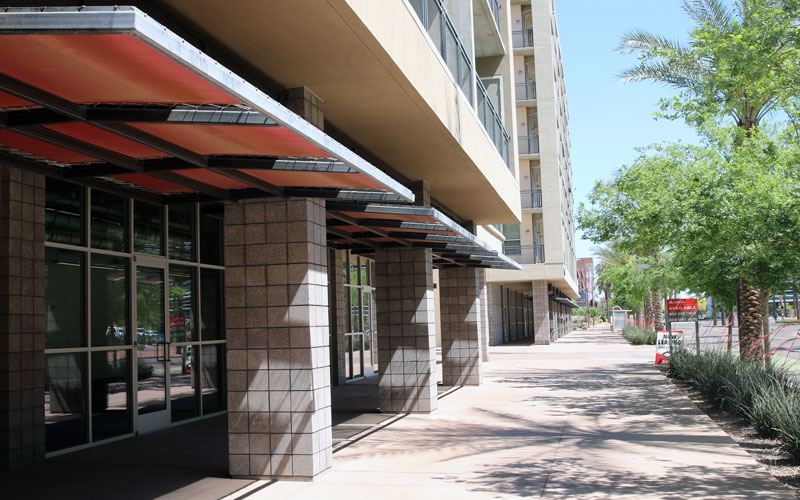
Developers sometimes face challenges when filling ground floor space. These vacant storefronts at the bottom of an apartment complex on the corner of 5th and Van Buren streets have been vacant for years. The complex pictured takes up an entire city block, but offers little in the way of lively and active ground floor features. (Photo by Lindsay Robinson/Cronkite News)
“It’s determining for that specific area what best suits the area at that time, and making sure something is flexible so as the market changes, it can change,” she said.
Build it and they will come?
A developer has to make money, and their primary way to do that, so far, is with housing, not ground-floor businesses, Klocke of Downtown Phoenix Inc. said. Since city policy only dictates that developments have pedestrian friendly designs on ground floors, that interpretation is up to the developer. A developer’s priorities rarely include retail.
“What you’re asking them to do, especially from a developer’s standpoint, is to focus on something that they’re not geared towards doing,” said Thomas Brophy, director of research for ABI Multifamily. “They’re building for families, they’re not building for retail space.”
And incorporating ground-level retail presents several challenges, including finding businesses to fill the space, Klocke said. The revenue is in housing.
“If I build a 300-unit apartment complex and 97 percent of my income is coming off of those units, I’m going to put my attention to those units,” Klocke said.
“We’ve got to be able to show developers that if you do it right, if you build it so there are the appropriate things for restaurants like grease traps and vents, that you can fill that space,” Klocke said. “It’s going to be an income generator, and it’s going to be an amenity that’s going to attract people to live or work in your building.”
Ground-level retail space is not the right fit for every developments but community members and city planners said neighborhoods along Roosevelt Street between 7th Avenue and 7th Street, which already have small businesses like restaurants and shops flanked by housing, is a good location for those uses.
“I believe that Roosevelt Street is an active street that warrants ground level uses,” Matt Seaman, principal developer at Metrowest Development, the firm behind Union @ Roosevelt, said. “Whether that’s retail or restaurants or live-work spaces, I think it needs to be something that allows for that pedestrian vibrancy on the street.”
Developing differently
The complexes rising from the ground along Roosevelt Street each reflect a different approach to ground-level retail, but some plans are being implemented with such space as a priority. Community advocates and city officials point to some developments as examples of success.
“Matt Seaman’s projects are a great example of how to do things that fit the character of the neighborhood,” Champion said. “But Matt also lives down here, and he’s invested in the community.”
Seaman said his company, Metrowest Development, strives to keep the character and needs of the neighborhood in mind while executing projects. Metrowest Development is planning for two — hopefully locally-owned — restaurants to move into Union@Roosevelt on the corner of 1st Avenue and Roosevelt Street on a lot that has been vacant for 65 years.
Seaman says that the company believes there is value in “location amenities” like bars, restaurants and coffee shops, rather than traditional amenities like pools and exercise rooms.
“Tenants in our building are going to recognize that they might rather have a wine bar and a restaurant and a coffee shop where they can socialize with other people in a public space, Seaman said. “That becomes an amenity for their building if it’s right below their apartments.”
By constructing an area on the ground floor that is intentionally designed for these kinds of services, Seaman says it will be easier for businesses, especially local ones, to move into the spaces.
“We are very intentional about creating spaces along Roosevelt street that are small spaces,” Seaman said. “They’re affordable spaces, so a small business person could come in here and open up and they’re not going to have an astronomical rent check.”
Other projects, like Alliance Residential Company’s plans along Roosevelt between 5th and 3rd streets, are also striving to incorporate commercial space.
PAZ Cantina and the building it was housed in, Canvas, were demolished last year to make way for the complex. A neighborhood convenience store, Bodega 420, was also demolished, and the historic Wurth House was relocated from the lot. The demolition reduced the building and various murals to rubble, and PAZ Cantina moved its business back into a food truck.
Michael Reyes, chef and owner of PAZ Cantina, says that his restaurant has a deal with Alliance to move into the first floor of the four-story complex.
Reyes said the process has been a struggle but he’s fortunate to have a spot in the new development. He said that developers and planners from Alliance visited the area, spoke with community members and attended events including multiple First Fridays, the monthly art walks along Roosevelt Street, to get a feel for the neighborhood.
“They really got to see what we did and how we did it and how the community took a liking to us,” Reyes said. “Because of that, they gave us an opportunity to be the anchor tenant on the corner.”
Reyes said that Alliance has been open to working with PAZ and will give them a blank slate to work with in the new building. He said that the new location will feature various mediums of art and murals from local artists.
“I could have never told you in a million years that I was going to have a Phoenician storyline to my life,” he said. “We literally got torn down, and all of the art that was there that was the spirit of PAZ got torn down with it. But it’s all going to come back up. It’s all coming back to life.”
Investing in downtown’s future
The criticisms and tensions marking the rapid growth of downtown Phoenix, say city officials, developers and community members, are necessary to balance growth and preservation.
“Are there a lot of apartment buildings being built? Yes. Is that a good thing? I think so,” Seaman said. “It’s going to bring more bodies down here, and when you have more bodies, then you can make the argument that it’s time for a grocery store, it’s time to have more restaurants and small business spaces because they can be supported. I think that’s the balancing act.”
“Neighborhoods have to recognize that there were a lot of people before them that really added value to the downtown and to the neighborhood,” he said. “It wasn’t just our group or this group today, there were a lot of things that happened way before any of us were down here. It’s these small, incremental gains that we’ve made that have allowed us to get to this point.”
The demand for a grocery store downtown will be met in 2018 when a 55,000 square-foot Fry’s Food Stores center will be built between Washington and Jefferson streets and 1st and 2nd streets. City officials said it might include offices and housing but focused mainly on the value of filling a consumer need.
City officials Mackay and Fletcher say it will take time for the retail side of downtown to fill in and flourish.
“Everybody expects things to happen so fast. You can’t have a lot of retail space and no density, but it takes a while for them to match up,” Fletcher said. “You have to have a place that people want to move to, and I think we’re finally seeing a lot of people who are excited about moving downtown. And then little by little, you have that need, and those spaces will fill up.”
Correction: A previous version of this article mislabeled the boundaries of the Walkable Urban Code. The boundaries outlined in the map represent the Downtown Code. The article also stated that Roosevelt Row was included as a character area in the Walkable Urban Code. The Roosevelt neighborhood is a character area in the Downtown Code.
